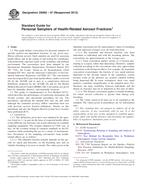Potřebujeme váš souhlas k využití jednotlivých dat, aby se vám mimo jiné mohly ukazovat informace týkající se vašich zájmů. Souhlas udělíte kliknutím na tlačítko „OK“.
ASTM D2010/D2010M-98(2010)
Standard Test Methods for Evaluation of Total Sulfation Activity in the Atmosphere by the Lead Dioxide Technique
Automaticky přeložený název:
Standardní Zkušební metody pro stanovení celkové Sulfatace činnosti v atmosféře vedoucímu oxidu Technika
NORMA vydána dne 1.10.2010
Informace o normě:
Označení normy: ASTM D2010/D2010M-98(2010)
Poznámka: NEPLATNÁ
Datum vydání normy: 1.10.2010
Kód zboží: NS-19025
Počet stran: 6
Přibližná hmotnost: 18 g (0.04 liber)
Země: Americká technická norma
Kategorie: Technické normy ASTM
Kategorie - podobné normy:
Anotace textu normy ASTM D2010/D2010M-98(2010) :
Keywords:
atmospheres, Huey plates, lead dioxide, lead dioxide candles, sampling, sulfation, sulfation plates, sulfur dioxide, Atmospheric analysis, Gases (atmospheric), Lead dioxide technique, Specimen preparation (for testing)--atmospheric analysis, Sulfation (total), Sulfuric acid, Sulfur oxide gases, Total sulfation, ICS Number Code 13.040.20 (Ambient atmospheres)
Doplňující informace
| Significance and Use | ||||||||||
|
Sulfur oxide gases are produced during the combustion of materials containing sulfur. These gases are precursors of atmospheric sulfuric acid, which has been shown to be injurious to living creatures and plants, as well as some inanimate materials such as metals, limestone and sandstone building materials. Sulfur dioxide is moderately toxic and strongly phytotoxic to many species. Permissible ambient levels of SO2 have been established by law. When it is necessary to establish whether ambient air concentrations of sulfuric acid precursors, such as sulfur oxides, are present and to comply with legal criteria, manual and automatic monitoring systems specific for the individual sulfur species are used. Likely locations for monitoring sites for the estimation of concentrations and concentration trends over long periods of time can be screened conveniently using the PbO 2 candles or sulfation plates. Atmospheric corrosion of metallic materials is a function of many weather and atmospheric variables. The effect of specific corrodants, such as SO2, can accelerate the atmospheric corrosion of metals or structures significantly. The PbO2 candle and sulfation plate test methods provide simple techniques to monitor SO2 levels in the atmosphere independently to yield a weighted average result. The results of these test methods are useful for characterizing atmospheric corrosion test sites regarding the effective average concentrations of SO2 in the atmosphere at these locations. These test methods are useful for determining microclimatic seasonal and long-term variations in effective average SO2 concentrations. The results of these test methods may be used in correlations of atmospheric corrosion rates with atmosphere data to determine the sensitivity of the corrosion rate to the SO2 level. These test methods may also be used with other test methods to characterize the atmosphere at sites at which buildings or other construction are planned in order to determine the extent of protective measures required for the materials of construction. |
||||||||||
| 1. Scope | ||||||||||
|
1.1 These test methods describe the evaluation of the total sulfation activity in the atmosphere. Because of its oxidizing power, lead dioxide (PbO2) converts not only sulfur dioxide (SO2), but other compounds, such as mercaptans and hydrogen sulfide, into sulfate. It fixes sulfur trioxide and sulfuric acid mist present in the atmosphere (see Note 1). 1.2 Test Method A describes the use of a PbO2 candle, and Test Method B describes that of a PbO2 sulfation plate. 1.3 These test methods provide a weighted average effective SO2 level for a 30-day interval. 1.4 The results of these test methods correlate approximately with volumetric SO2 concentrations, although the presence of dew or condensed moisture tends to enhance the capture of SO2 onto the candle or plate. 1.5 The values stated in SI units shall be regarded as the standard. The values given in brackets are for information only and may be approximate. Note 1—It has been shown that the rate constant of the chemical reaction between SO2 and PbO2 is independent of the concentration of SO2 up to levels of 1000 ppm(v), if 15 % or less of the PbO2 has been reduced (1). 15 % of the PbO2 is equivalent to 11 to 12 mg of SO2/cm2 per day. 1.6 This standard does not purport to address all of the safety concerns, if any, associated with its use. It is the responsibility of the user of this standard to establish appropriate safety and health practices and determine the applicability of regulatory limitations prior to use. For specific precautionary statements, see Section 8. |
||||||||||
| 2. Referenced Documents | ||||||||||
|
Podobné normy:
Historická
1.4.2012
Historická
1.4.2008
Historická
1.3.2009
Historická
1.4.2013
Historická
1.4.2010
Historická
1.10.2012



 ASTM D6062-07(2012)..
ASTM D6062-07(2012).. ASTM D6177-97(2008)e..
ASTM D6177-97(2008)e.. ASTM D6196-03(2009)..
ASTM D6196-03(2009).. ASTM D6209-13
ASTM D6209-13 ASTM D6271-10
ASTM D6271-10 ASTM D6328-12
ASTM D6328-12
 Cookies
Cookies
